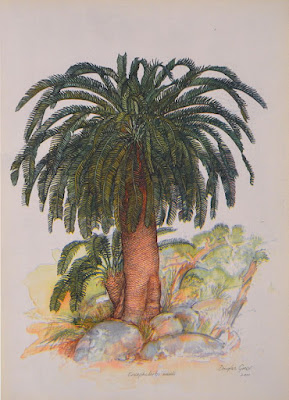The tragic end of an ancient being
Encephalartos woodii, the loneliest creature in the world
We have already talked about hypothetical species, and everything, but what would it be like if one of these had been in captivity all their lives? Well, here we have a possible answer, with this species.
Encephalartos woodi, is a plant supposedly extinct in the wild, discovered at the end of the 19th century in what is now Africa, is a cycad of the genus Encephalartos, endemic to the Natal area of South Africa.
John Medley Wood, curator of the Durban Botanic Gardens and director of the Natal Government Herbarium of South Africa, who discovered the specimen in 1895, when he was investigating in a Ngoya forest and observed an unusual palm tree according to his words, which years later was discovered to come from a lineage that was present since the era of the great dinosaurs, being food and shelter for these giants from the earth's remote past, but managing to survive extinction, collecting a few sprouts, of which only one survived and is today found in a boanical garden in the United Kingdom.
It measures 6m, having a crown of 50–150 leaves, the male strobili are cylindrical, between 20 to 40 cm long, exceptionally up to 120 cm, and 15–25 cm in diameter; Being bright orange in color, a single plant can produce around six to eight simultaneously, although female cones are unknown.
All the specimens acquaintances of Encephalartos woodii they are clones de esa only known plant, despite several inspections, no other plant has been located in nature, For these reasons, the plant is considered an extinct species in the wild, the only known E. woodii plant in nature were a cluster of four stems from a plant discovered by Wood in 1895 in a small area of the Ngoya forest, in what is now South Africa, the smaller shoots were cut in 1903, another expedition collected the two smaller stems and placed them in botanical gardens, the larger one died during the period 1907 to 1912, the last stem was removed from the wild in 1916 and sent to Pretoria, where it subsequently died in 1964.
Even worse, these are plants that only reproduce by union of gaments, and that is why it is necessary to discover even a single female plant, to reproduce them naturally and create pure offspring, otherwise, this old cicada only has to wait for the end, and each year the probability that there will be another one like the one out there is reduced, however, reproduction can occur to give rise to fertile hybrids with E. natalensis, If each offspring is subsequently crossed with E. woodii, after several generations, the female offspring will be close to what female Encephalartos woodii would look like, but it would be very unviable and time passes as the old giant ages, and the chances of finding a female get lower and lower, leaving this solitary being facing extinction, lonely and without ever having met another member of his species.
Just as it is for this plant, it has been a cruel reality that many species over time have faced, being the last known living member of a species, and it must be strange to die alone, waiting to see someone else like them, without knowing that it will never arrive and suddenly knowing that you will die, without knowing if yours are alive or not, something that surely awaits several species in the future, and Possibly, it is what happens when the only man is on earth.
[Reading links]
https://en.m.wikipedia.org/wiki/Encephalartos_woodii






Comments
Post a Comment